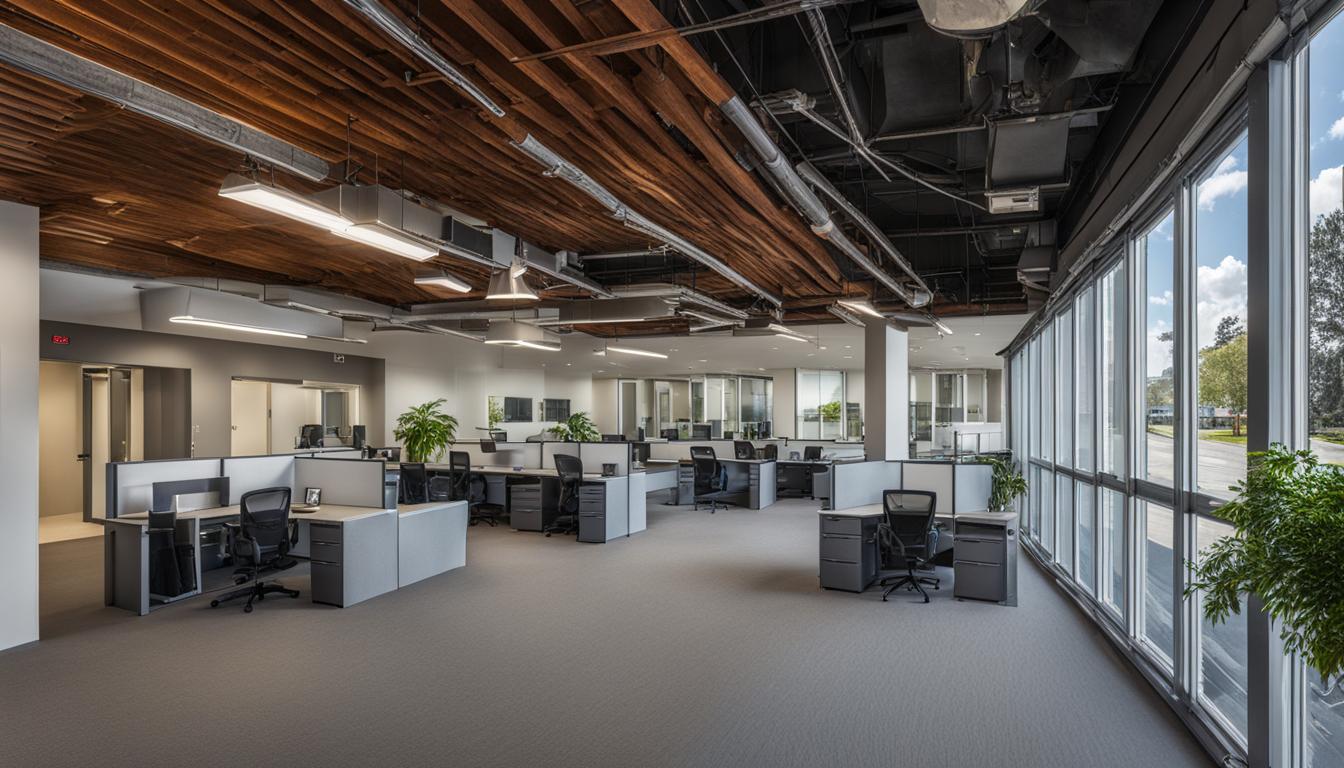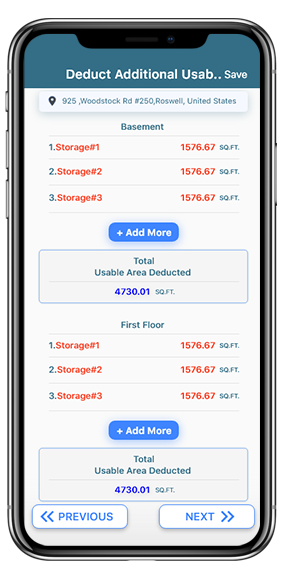Understanding usable square footage is crucial for commercial real estate tenants. As a tenant, you want to make sure you know exactly how much actual space you’re getting for your money when signing a lease. In this guide, we’ll explain what usable square footage (USF) is, how it differs from rentable square footage, and why the difference matters from a tenant’s perspective. We’ll also provide tips on how to calculate and compare rentable vs usable square footage so you can negotiate the best deal.
What Is Usable Square Footage (USF)?
Usable square footage (USF) refers to the actual amount of space inside a commercial unit that the tenant can utilize exclusively. This includes all areas within the walls, doorways, and permanent hallways of a rented space.
Simply put, usable square footage is the amount of floor area that is for the tenant’s exclusive use. Usable square footage does not include common areas shared with other tenants such as lobbies, hallways, stairwells, elevators, and restrooms.
For a tenant, the usable square footage determines how much space they have for their business operations. It is the space they can occupy and customize to suit their needs.
How Usable Square Footage Differs from Rentable Square Footage
While usable square footage refers to the tenant’s actual space, rentable square footage encompasses a larger area.
Rentable square footage includes the usable area plus a proportional share of building common areas like lobbies, corridors, and amenities. So rentable square footage will always be larger than the usable square footage.
For example, say a tenant is going to lease a space with 1,000 square feet of usable area. If the building’s common area is 10,000 square feet, and there are 40,000 square feet of usable tenant space, that tenant’s share of the common area would be 10,000 x (1,000/40,000) = 250 square feet.
So the rentable square footage would be 1,000 usable sq ft + 250 square feet of common area = 1,250 square feet.
This “load factor” allows landlords to split up common area rent proportionally among tenants. Tenants pay rent on their share of usable plus common areas.
Why Understanding the Difference Matters for Tenants
For commercial tenants, the key difference between usable and rentable square footage comes down to cost. Rent is based on the rentable square footage, not the usable area.
Tenants pay proportionally more for space due to their share of common areas. This increases a tenant’s total rent obligation compared to just the usable space alone.
For example:
- Usable SF: 1,000 ft2
- Rentable SF: 1,250 ft2
- Rent Rate: $20/ft2
- Rent based on Usable SF: $20,000/year
- Rent based on Rentable SF: $25,000/year
In this case, the landlord pockets an extra $5,000/year without providing any additional usable space.
As a tenant, it’s critical to understand this difference before signing a lease. Know exactly how much usable space you’re getting and how common area costs impact overall rental rates per square foot.
A few key things tenants should look at:
- Load factor – The lower the load factor, the less difference between usable and rentable sf. Look for buildings with an efficient layout and low load factors.
- Compare base rents – Don’t just look at the rate per square foot; look at the total base rent as well. A lower PSF but a higher load factor can mean higher overall rent.
- Common area maintenance fees – Beyond base rent, tenants pay their share of operating expenses for common areas. Understand what’s covered in these CAM fees.
While rentable square footage rent is standard in commercial leases, understanding the distinction from the actual usable area is crucial for tenants to avoid overpaying.
How to Calculate Usable and Rentable Square Footage
When evaluating potential spaces as a tenant, you’ll want to break down the usable and rentable square footage yourself to determine total occupancy costs. Here are some tips on calculating each:
Calculating Usable Square Footage
To determine usable space:
- Measure interior walls – Measure the distance between the inside finished wall surfaces, excluding wall thickness. This includes all areas enclosed within permanent walls.
- Include service areas – Hallways, restrooms, breakrooms, storage closets, etc. located within the tenant’s space.
- Exclude common areas – Any common building spaces (lobby, corridors, amenities), even if located within the suite.
- Calculate irregular spaces – For irregular-shaped areas, take multiple measurements and use formulas for triangles, circles, etc, to find total usable space.
This will give you the accurate, usable square footage number to use in the rental analysis.
Calculating Rentable Square Footage
The rentable square footage calculation includes the following:
- Usable area – The usable square footage as measured above
- Add proportional common area – Using the load factor formula above, add the proportional share of common space for the tenant suite.
- Check landlord’s numbers – Verify the landlord’s quoted rentable figures based on total building common space and ratios.
Doing this calculation yourself provides a good double-check on the rentable square footage to avoid overpaying rent.
Comparing Load Factors and Rentable vs Usable Square Feet
To compare spaces and analyze your rent costs, you’ll need to look at the building’s load factor and rentable vs usable ratio.
The load factor is the percentage of rentable square footage allocated to common areas. A lower load factor is better for tenants. Newer buildings typically have more efficient layouts and load factors below 20%. Older buildings can have load factors of 40% or higher.
Then, look at the rentable vs usable square footage. Taking the rentable sf divided by the usable sf gives the rentable/usable ratio. Again, a lower ratio is better for tenants – a ratio of 1.15 means the rentable sf is 15% greater than usable.
Comparing these metrics helps tenants identify buildings designed more efficiently. For your business, prioritize spaces with lower load factors and rentable/usable ratios to optimize usable space for your money.
Just looking at rental rates per square foot doesn’t provide the full picture. Doing a little more digging into load factors and rentable vs usable sf differences can yield big savings on your lease.
Simplifying the Usable Square Footage Calculation with U/R Simple
What is the U/R Simple App?
In the intricate world of commercial real estate, calculating usable and rentable spaces can be a daunting task. U/R Simple emerges as a revolutionary tool, meticulously designed to simplify this complex process for industry professionals like architects and commercial draftsmen.
Customized Calculation Options
U/R Simple offers a reprieve from traditional, time-consuming calculation methods. It provides four customized options, accommodating different building types and location scenarios, from single-story to multi-story properties with varying load factors. This adaptability ensures accuracy and efficiency, tailored to specific needs.
Streamlining the Process
Gone are the days of cumbersome, manual calculations. U/R Simple’s user-friendly interface allows for easy calculation, adjustment, and storage of data, all in one place. This step-by-step tool transforms the traditionally arduous task of calculating usable and rentable square footage into a more manageable and efficient process.
Standout Features
Beyond basic calculations, U/R Simple enhances the user experience with several key features:
- Property Tracking: A built-in locator map for effortless tracking of all properties, eliminating manual record-keeping.
- Secure Data Storage: Reliable storage for calculation data, ensuring accessibility and retrievability.
- Automatic Adjustments: The system enables automatic adjustments, streamlining recalculations and minimizing manual corrections.
- Export and Share: An option to export calculations in PDF format, facilitating easy sharing with teams or clients.
U/R Simple is not just a tool; it’s a game-changer in the realm of property space calculations. It offers simplicity, efficiency, and convenience, redefining the way property calculations are performed in the commercial real estate industry. With its innovative features and user-friendly design, U/R Simple stands out as an indispensable resource for professionals seeking to streamline their calculation process and achieve accurate results with ease.
Key Takeaways on Usable vs Rentable Square Feet
- Usable square feet (USF) refers to the actual space available for the tenant’s exclusive use.
- Rentable square footage includes the usable area plus a share of common building space.
- Tenants pay rent based on the rentable square footage, not usable square footage.
- Understanding this difference allows tenants to accurately compare spaces and avoid overpaying rent.
- Tenants should calculate the usable and rentable square footage themselves to evaluate total occupancy costs.
- Prioritize spaces with lower load factors and rentable vs usable ratios to maximize usable space.
Knowing the distinction between usable and rentable square footage is key for tenants negotiating their best lease deal. Keep these differences in mind as you evaluate commercial real estate spaces to make the most informed leasing decision.




